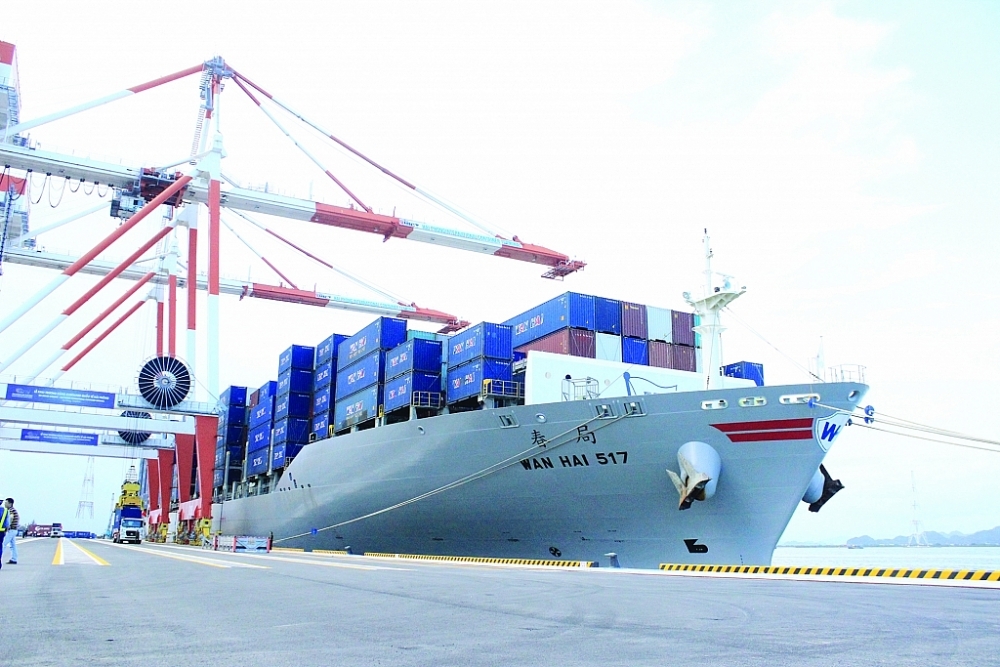Unreasonable difference
 |
| 90% of Vietnam's imports and exports go through seaports |
Development of water transport – What is needed?
In current modes including road, inland waterway, sea and air, road is still the first choice for enterprises even though the transportation cost of this type is not the most optimal. The reason for the high cost of road freight transport is the ineffective road transport infrastructure with expressways and the secondary roads. In areas near seaports, congestion still occurs, in addition, the high number of toll booths is also one of the many reasons for the high transportation costs.
According to Ms. Dang Minh Phuong, Chairman of MP Logistics Company, costs in the logistics industry are still high, so it is necessary to take measures to reduce them. We neglect waterways and railways in transport infrastructure development, the use of sea transport is not high, and 80% still use road transport while Vietnam has a long coastline. In addition, the connection of transport infrastructure among waterways, roads and railways is limited.
According to a review by the World Bank, in the 2011-2015 period, the inland waterway sector accounted for 2-3% of the annual budget invested in the transport sector. However, in the 2016-2020 period, this rate decreased by 1.2% of the budget estimate. Such investment is not sufficient for expansion and maintenance.
After decades of development, the length of the inland waterway transport network receiving barges of over 300 tons accounts for only 30% of the 7,000 km of the entire route. This is very low compared to the world's most successful commercial inland waterway systems.
Notably, reducing the proportion of investment in road infrastructure by 2-3% will not cause an impact on transport efficiency. Increasing investment in water transport by 2-3% will bring huge economic benefits to the country, because the average cost per ton of road transport is five times higher than transportation on inland waterways.
Many experts believe that the limitation of infrastructure, especially the inland waterway transport corridors, has hindered the development of Vietnam's inland waterways sector.
Many ports have outdated facilities with low levels of mechanization, or poorly maintained or poor connection with the hinterland. Meanwhile, all the inland water transport networks of China, Europe and the United States are well-developed for vessels with a tonnage of more than 1,000 tons to operate. Normally, this load is even bigger.
To develop cargo transportation using inland waterways, it is necessary to strengthen connectivity, develop methods of transport, maximize multimodal transport and logistics services. It is essential to call for investment in the development of inland waterway ports exploiting container cargo with a function in the Northern region and the Mekong River Delta with synchronous and modern facilities and equipment for loading and unloading to rapidly increase the market share of container transport by inland waterways.
It is necessary to have solutions to connect inland waterways with seaports on the basis of investment in the construction of inland waterways and anchorage berths in seaport waters (Hai Phong, Nghi Son; Ba Ria - Vung Tau; HCMC) to efficiently exploit seaport infrastructure in the area, minimize the number of inland waterway vessels waiting for cargo handling and loading due to lack of ports or terminals; thereby facilitating good connection of seaports with regions and concentrated commodity production areas by inland waterways.
Redundant place, shortage
According to statistics by the Maritime Administration, Vietnam currently has nearly 1,600 ships, of which, cargo ships are 1,128 with a total capacity of about 4.8 million GT and a total tonnage of about 7.8 million DWT (ton length).
The United Nations Conference on and Trade and Development (UNCTAD) ranked the Vietnamese fleet fourth in the ASEAN region (after Singapore, Indonesia, Malaysia) and 30th in the world. Despite relatively good growth, the Vietnamese fleet currently only meets the demand for domestic transport and feeder transport (freight consolidation service) in some countries in the region, it has not yet increased its market share in terms of import and export goods.
The fleet of ships is currently responsible for transporting about 7% of goods on routes to China, Japan, South Korea, and Southeast Asia. Likewise, the Vietnamese container fleet operates mainly on short-haul routes in Southeast Asia and Northeast Asia, with only a few bulk carriers on European routes. The rest of the container fleet is generally small in terms of tonnage, age of ships, and slow speed compared to the container fleets of foreign firms.
Limited capacity makes Vietnamese shipping and logistics enterprises mainly take on work in the domestic market, acting as agents for foreign shipping lines. The international shipping activities that bring about high added value are all held by major shipping lines. These are the difficulties and challenges for Vietnamese shipping companies when approaching the European market.
The Vietnam Association of Logistics Service Enterprises said that with more than 90% of Vietnam's import and export goods going through seaports, the allocation of seaports still has a shortage.
For example, in the Mekong Delta, there are about 65% of agricultural products, 70% of fruits for export, however, due to the lack of deep water ports in this region, import and export goods must pass through seaports in the HCMC and Ba Ria-Vung Tau.
If a deep-water ports are formed in the Mekong Delta, the logistics costs incurred in transporting goods for export will be significantly reduced. For example, the cost of transporting rice will decrease by about US$10 per ton compared to moving from the Mekong Delta to Ho Chi Minh City by road.
Therefore, according to many experts, Vietnam needs to invest in infrastructure to reduce traffic congestion, and promote the use of container shipping by barge to increase the use of inland waterway transport, further promote the development of coastal transportation on the North-South route as well as focus on enhancing the capacity of the fleet of ships, which is a priority.
In addition, it is also necessary to integrate logistics centers and integrated urban centers in the planning of inland container ports to reduce "door to door" costs, and improve competitiveness among transport methods such as waterways, sea and road.
Related News

Complying with regulations of each market for smooth fruit and vegetable exports
13:06 | 09/01/2025 Import-Export

Coconut export enter acceleration cycle
11:02 | 30/12/2024 Import-Export

Increasing consumption demand, steel enterprises have many opportunities
07:43 | 31/12/2024 Import-Export
Latest News

Việt Nam tightens fruit inspections after warning from China
08:01 | 15/01/2025 Import-Export

Brand building key to elevate Vietnamese fruit and vegetable sector: experts
08:00 | 15/01/2025 Import-Export

Freight transport via China-Việt Nam cross-border trains posts rapid growth
08:01 | 13/01/2025 Import-Export

Vietnamese retail industry expects bright future ahead
06:22 | 11/01/2025 Import-Export
More News

Fruit and vegetable industry aims for $10 billion in exports by 2030
15:12 | 07/01/2025 Import-Export

GDP grows by over 7 per cent, exceeds target for 2024
15:11 | 07/01/2025 Import-Export

Vietnamese pepper: decline in volume, surge in value
15:10 | 07/01/2025 Import-Export

Việt Nam maintains position as RoK’s third largest trading partner
15:09 | 07/01/2025 Import-Export

Greater efforts to be made for stronger cooperation with European-American market
15:08 | 06/01/2025 Import-Export

Leather, footwear industry aims to gain export growth of 10% in 2025
15:06 | 06/01/2025 Import-Export

Grasping the green transformation trend - A survival opportunity for Vietnamese Enterprises
14:53 | 06/01/2025 Import-Export

Việt Nam to complete database of five domestic manufacturing industries in 2026
20:57 | 05/01/2025 Import-Export

Logistics firms optimistic about growth prospects in 2025: Survey
20:54 | 05/01/2025 Import-Export
Your care

Việt Nam tightens fruit inspections after warning from China
08:01 | 15/01/2025 Import-Export

Brand building key to elevate Vietnamese fruit and vegetable sector: experts
08:00 | 15/01/2025 Import-Export

Freight transport via China-Việt Nam cross-border trains posts rapid growth
08:01 | 13/01/2025 Import-Export

Vietnamese retail industry expects bright future ahead
06:22 | 11/01/2025 Import-Export

Complying with regulations of each market for smooth fruit and vegetable exports
13:06 | 09/01/2025 Import-Export
